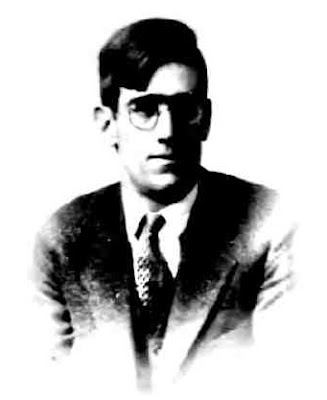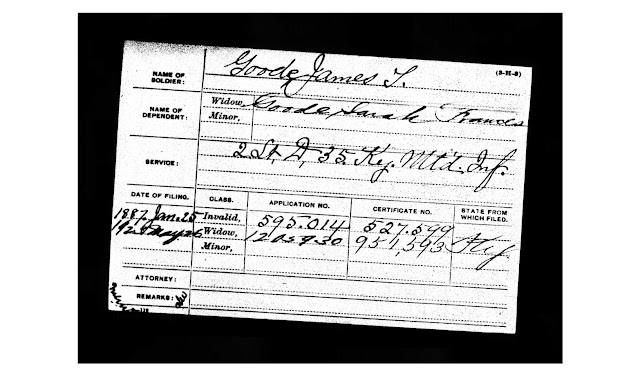Google Search on Archie Shields Turns Up Surprise Collection of Papers in Library Archives at University of Michigan
Archibald Shields: 1899-1965
Great-Uncle Archie Shields (brother of Grandmother May
Shields Aird) turned out to be a
man of many surprises. My initial research unearthed his World War I military
records, detailing his service with the Canadian Expeditionary Forces. This
would have made perfect sense if Archie had been Canadian, but he was born and
raised in the United States. How did he end up enlisting in Canada? While
trying to solve this puzzle, I conducted a Google search on his name and
military unit. To my surprise, the search pulled up his name as the subject of
a collection of letters, papers and photographs held in a research library at
the University of Michigan! I had to know more!
 |
| Passport photo of Archie as a young man |
Apparently Archie's letters to family members from his time in the Canadian military were donated to the Manuscripts Division of the William L. Clements library sometime around 2019. The materials are open for research, so can be requested for viewing and reading at the library.
 |
| Vintage postcard of the William L Clements Library building |
The library's information on the collection includes an excellent summary of Archie’s life,
as follows:
“Archibald
"Archie" Shields was born September 7, 1899, in Hamilton, Ohio, to
Jane Mary Seller Pollok (1868-1954) and John Sutherland Shields (1865-1959).
Both of his parents were originally from Scotland and resided in Dutch Suriname
for a time before immigrating to the United States. Shields had four sisters:
Mary "May" Seller Shields (1893-1988), Margaret Sutherland Shields
(1896-1993), Bethia Jane Shields (1901-1978), and Ruth Dorothy Shields
(1904-1995). In 1916, seeking independence, Shields ran away to Windsor,
Ontario, Canada, and joined the 99th Battalion of the Canadian Expeditionary
Force. Following the war, Shields studied fruit farming at Michigan State
University and worked for several years in Barahona, Dominican Republic. After
returning to Detroit, he worked as a salesperson for Hudson's, Kern's, and the
Foley Company. Archie Shields married Ruth Harvey Patterson (1904-1994) on July
2, 1928. He died on April 2, 1965, and is buried in North Farmington Cemetery
in Farmington Hills, Michigan.”
The library also provided a synopsis of the collection’s contents,
which sound absolutely fascinating. Here is the library’s description:
‘This collection is
made up of 71 items, including 28 letters written by Archibald
"Archie" Shields of Detroit, Michigan, to his parents and sisters
while serving in the Canadian Expeditionary Force during World War I. Shields
served in France on the Western Front and, while on leave, visited friends and
family in Scotland. The remaining materials include documents, ephemera,
photographs, printed items, and one VHS tape.
“The Correspondence
Series is comprised of 28 letters written by Archie to his parents and sisters
during his time in the Canadian Infantry during World War I. The correspondence
begins when Shields's battalion mobilized in May 1916. He quartered in London,
Ontario, Canada, for several weeks before traveling through Toronto, Montreal,
and New Brunswick, to board the troop ship Olympic at Halifax, Nova Scotia.
After arriving in England in early June, the battalion was stationed at
Otterpool Camp in Kent, where Shields applied for a transfer to become a driver
and the 99th Battalion dissolved into the 35th. Towards the end of September,
Shields went to France as part of the 21st Battalion. Admitted to the hospital
in March 1917 for "swollen glands and sore throat," he became a
patient in the 16th General Hospital in France, 1st Southern General Hospital
in Birmingham, and Hillingdon House Hospital in Uxbridge. Following his
recovery, Shields spent time visiting relatives and family friends in Scotland but
was punished upon his return for taking longer leave than approved. He took
subsequent leaves to Paris and Scotland. The last of the letters is dated
November 5, 1918.

RMS Olympic in WWI--troop ship that carried Archie to England
“Shields's letters
include descriptions of camp life and military training (marksmanship,
stretcher bearing, trench digging), requests for parcels, requests and comments
on news from home (include fundraising efforts), notes on letters and packages
received, comments on friends' and relatives' military experiences, and remarks
on his own experiences (including censorship, shelling, and life in the
trenches). Envelopes are included with most letters, many with an "Opened
By Censor" label attached. Shields wrote some of his letters on YMCA
"With His Majesty's Canadian Forces on Active Service" stationery.

Hat pin for Archie's battalion, the 21st Canadian
“The Documents and
Ephemera Series contains a worn black wallet with two colorful military uniform
bars, a small black flip notebook, three Canadian Expeditionary Force pay
books, and items commemorating the installation of a memorial window at St.
Paul's Anglican Church in Kingston, Ontario, Canada, in 2007. Contained in the
black wallet are a photograph of Archie Shields in uniform, a 1922 10,000
reichsmark note, and a military pass. The black notebook contains names and
addresses of acquaintances, military tactics notes, and brief journal entries
respecting Shields's time at the front in France until his admission to the
hospital in England; in its pocket is a torn scrap of paper with the header
"Plantation Alliance, Suriname, Dutch Guyana." Laid into one of
Shields's pay books are assorted papers, including a telegram from his Aunt
Effie, railway tickets, calling cards (Clarisse Dalouze and Marie Dalouze of
Trazegnies, Belgium, and Armand Loutz of Spy, Namur, Belgium), and a postcard
from a watch repair shop.”
There are so many wonderful items in this collection that I
want to see, read and copy for family records. The library provided so many tantalizing
pieces of information--such as Archie’s agriculture studies in fruit
propagation that led to work in the Dominican Republic, and his visits to Shields
family members in Scotland--that I had not discovered through traditional
research. The collection also includes photos that we have never seen. I
checked with other family members, and none were aware that Archie’s papers had
been donated to the University of Michigan Libraries. I assume one of his
children made the donation, but I have no evidence to support my supposition.
 |
| Archie Shields later in life... |
I am eager to visit the William L. Clements Library at some
point to see the collection in person, as the materials are not available
online. I am so grateful that I decided to Google Archie’s name! What a
wonderful surprise!
Sources:
Archie
Shields papers (1916-1918, 2007, bulk 1916-1918). Collection processed and
finding aid created by Sara Quashnie, February 2019. Manuscripts Division,
William L. Clements Library, University of Michigan.
https://quod.lib.umich.edu/c/clementsead/umich-wcl-M-7108shi?id=navbarbrowselink;view=text
Shields, Archibald. Personnel Records of the First World War, Library and Archives Canada, http://central.bac-lac.gc.ca/.item/?op=pdf&app=CEF&id=B8864-S023. Accessed February 22, 2019
Aird, John
Shields. Memoirs of John S. Aird,
http://www.steveaird.org/Steve_Airds_Homepage/John_Shields_Aird_files/Memoirs%20of%20John%20S.%20Aird.pdf.
Accessed February 20, 2019.





















